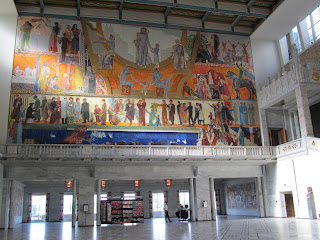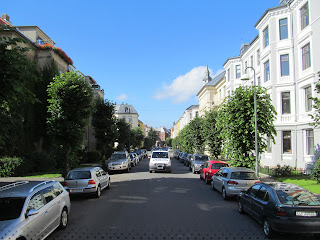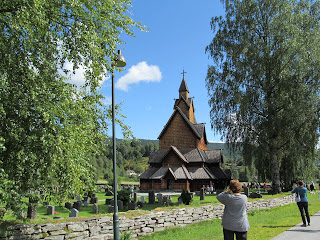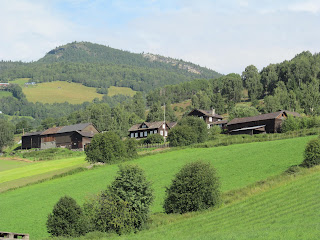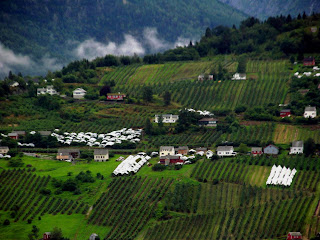I woke up with a migraine headache this morning which was definitely not in my plans. However, I managed to shake it by late morning so the day wasn't a total mental washout. We had wonderful sunshine (albeit not good for my head) all day for the trip through eastern Norway which was generally good farmland. We followed Lake
, Norway's largest lake, for much of the way making this a very scenic drive with the lake on one side and farmsteads with large red barns with outbuildings and white homes on the other. Barns are typically made wholly, or in large part, of stone on the bottom with wood above. I saw mostly small grain (oats, wheat, barley, rye, etc.), potatoes, and hay being grown and we were told an effort is under way to try to adapt corn to the climate here. Hay is typically baled in round bales covered with white plastic. The hay ferments while in the plastic creating silage which is fed to cattle. Hay to be fed to horses is typically hung to dry in the traditional manner over horizontal poles raised off the ground.
 |
| Building adjacent to the top of the ski jump |
FAST FACTS: Norway's size is between California and Montana and its population is approximately 4.7 million people. The country is the least densely populated country on the European mainland. Only about 3% of the land is suitable for farming. The Viking Age lasted from approximately 800 to 1050 A.D. The introduction of christianity marks the end of the Viking Age.
MONDAY, JULY 30, 2012 (Lillehammer to Loen)
This morning we drove the E6 highway up the Gudbrandsdalen Valley, following the Lagen River for many miles through forest and farm land. This is truly a beautiful valley! About an hour north of Lillehammer we left behind the white houses/red barns and began seeing mostly dark wood-colored farm houses and outbuildings. We also began seeing quite a few grass roofs.
 |
| Gudbrandsdalen Valley |
A stop for coffee was made in Kvam which has quite a history. In 1612 local farmers stopped Scottish invaders nearby when they were signalled by a girl, posted on a mountain across the river, to begin rolling logs down the hillside. Any surviving Scots were then killed by the locals. During WWII British soldiers had ferocious fighting against the Germans in this area and Kvam was destroyed during the battle. I picked up a fascinating booklet about the WWII battle here. I am sure there must also be information about the battle on the internet--it is really quite a story.
We turned west at Otta and followed the Otta River and Vaga Lake for many miles. Another beautiful drive! We saw more sheep as we drove further into northern Norway. The sheep are allowed to roam free in the mountains during the summer and are shorn in the spring and fall. They are kept in barns during winter.
 |
|
Driving west of Otta |
A stop was made at Lom to take pictures of the Stavkirke which was built in 1240. Only 28-30 stav churches remain in Norway of the 900+ at the height of their numbers.
 |
| Lom Stavkirke |
The lunch stop was at Grotli where most of us tried the soup with lamb sausage and root vegetables. It was mostly sausage and didn't pass the "good taste" test for most of us on the tour! Norwegians eat less vegetables than any other Europeans, so I guess it was no wonder we could hardly find them in the soup. <G>
 |
| Grotli |
There were interesting photos and stories about an aerial fight near here in 1940 during which a German Heinkel was shot down by a British SKUA. One of the three SKUA developed engine failure and also went down in the area. The two British airmen found a cabin for shelter and later on the three surviving Germans that had just been shot down found the same cabin for shelter. It was said the two crews entered a silent truce. The story continues on but the Germans were sent out as POWs to England and Canada. The British airmen were sent on to Trondheim where they were shot down.
 |
| Grotli: Mock-up of Heinkel used in a movie |
We continued on westward and drove up to "Dalsnibba", a UNESCO site. The road up the mountain was awesome with one hairpin turn after another and drop-offs descending for several thousand feet over the side of the narrow road. (The faint-of-heart in the group did not appreciate the drive up Norway's highest road at all.) Guard rails were just installed last year!
 |
Climbing up to Dalsnibba
Yes, there is a road waaay down there! |
However, the view of the head of Geiranger Fjord was incredible from this vantage point! Interestingly, two of my favorite songs came to mind on this drive: "Climb Every Mountain" and "Wind Beneath My Wings". Two very different songs, but somehow they seemed to fit the mood of the moment.
 |
| Geirangerfjord from Dalsnibba |
 |
| Geiranger |
After descending from the heights (5,000 feet), we boarded a ferry for the cruise down Geiranger Fjord, described as the "King of Norwegian fjords". This was an absolutely incredible trip on an absolutely beautiful afternoon! The steep forested canyons drop right into the water and the whole scene is as beautiful as one can imagine.
 |
| Geiranger Fjord |
Geiranger Fjord: "Seven Sisters" cascade

After docking at Hellesyit, we continued to drive west passing by Lake Hornindal which, at 540 meters deep, is the deepest lake in Europe. We crossed the head of Nordfjord and continued to our hotel in Loen.
 |
| On the road to Loen |
 |
| Lovatnet Lake from my hotel room |
 |
| Loen |
After dinner I walked to the Loen Church (Kirke) where I found my first geocache in Norway: GC28ZM2, Loen Kirke. Although there has been a church here since 1360, the current church was built in 1837. It is octagonal and has a 1,000 year old celtic cross in front of it. The cross is one of the oldest Christian monuments in the country. This brought to end a very full day of sightseeing which began early and ended late in the evening.
 |
Loen Kirke
Celtic Cross |
Geocache: GC28ZM2, Loen Kirke
FAST FACTS: Our tour guide has visited 43 of the U.S. states and will come to visit more this fall. She is from Holland and continues to live there when not travelling--she has visited 70 countries. She and her husband have a cabin near Lillehammer which they visit as they can. Her love of Norway was clearly evident during the tour.
Norway's mountains are very old and the treeline is at 3,000' MSL. One-half of the European continent's glaciers are in Norway. They tunnel THROUGH mountains instead of going over them. The main trees in northern Norway are the Norway spruce, birch, and Scotch pine.
TUESDAY, JULY 31, 2012 (Loen to Stalheim Hotel)
Our guide said the buffets at the Alexandra Hoel in Loen would be the best of the trip--and they were spectacular. If anyone went away hungry, it was strictly their fault! Breakfasts and dinners are included on most days of the trip and the food so far has been excellent with a good variety. The coffee in Norway isn't as strong as it is served in Sweden, but is excellent none the less. Coca-Cola and Sprite are readily available in both countries but, if you only like Pepsi, you will really have to hunt for it. A cheese specialty in Norway is Norwegian brown cheese which is made with goat milk. It is quite sweet, but good.
In the morning we drove past an arm of Nordfjord for some distance before turning into Vatedalen Valley and past Lake Jolster, both of which can only be described as serene. Along the way we passed quite a few goats and a few cattle grazing in the mountain meadows or crossing the road in front of us. (It is open range here.) Low goat milking sheds were frequently seen above the road.
 |
| Nordfjord |
 |
Vatedalen Valley
|
 |
| Lake Jolster |
We continued on to the Jostedalsbreen Glacier, the largest glacier in Europe. As with glaciers in the U.S. and elsewhere, this glacier is receding at a very fast pace. We visited a glacier museum in this location which was very interesting as they showed how earlier people traveled using cross-country skiis on the glacier from village to village before roads were built.
 |
| Jostedalsbreen Glacier |
During the afternoon we drove along Sognefjord, the longest fjord in Norway, and in the world, at 120 miles. It is also the deepest at over 4,200 feet. Russian submarines have been seen on occasion in the fjord. A two-hour ferry ride on the fjord was very enjoyable with more incredible scenery along the way.
 |
| Sognefjord |
We continued on to Flam where we rode the famed Flam Railway through incredibly wild and magnificent mountain countryside with steep canyon walls, waterfalls, and small farms dotting the area. The train went through many tunnels and even made a 180 degree turn INSIDE one mountain tunnel. We stopped at one large waterfall and a lady "troll" danced and sang on a ledge overlooking the falls.
 |
| Flam Train Ride |
We arrived at the Stalheim Hotel which is on a high perch overlooking a valley. The hotel has a garden that attracts visitors not staying at the hotel to come and enjoy the view. Stalheim was a stopping-off place for travelers on the Royal Mail route between Copenhagen, Oslo, and Bergen between 1647 and 1909. A road for horses and carriages was built in 1780. Prior to the Nazis overtaking the hotel in WWII, antiques dating back to the 1600s were removed beforehand and saved. Many of the antiques are displayed in the hotel now. One of the uses of the hotel by the Nazis was as a maternity ward. I won't go into too much detail about their program of encouraging Nazi officers to date and/or marry Norwegian girls as a means of further establishing their (Nazi) idea of the ideal race because it is quite a long and involved story with many sordid endings. ("Lebensborn" Program) Anyone wanting to know more can contact me and I will send a link to a website that explains a lot of the program and the ramifications on the women who dated/married Nazis and their children. From my perspective, it is a sad chapter in Norway's history.
 |
| Stalheim Hotel |
FAST FACTS: I did not see any traditional costumes on the trip other than those worn by docents at an open air museum. We were told that traditional dressy costumes are widely worn in the country to weddings by attendees.
In spite of very high subsidies, many farms are abandoned when the sons choose not to take over the farms when fathers retire. The land then reverts back to the government.
Norway has many long tunnels. We drove through several that were 4-6 miles long. The longest is about 15 miles.
WEDNESDAY, AUGUST 1, 2012 (Stalheim to Bergen)
We drove to Bergen in the morning with a brief stop in Voss, the scene of many sporting activities, earning it the reputation of being Norway's adventure capital. It is a scenic little town, situated on a lake, that has largely been rebuilt after being heavily bombed by the Nazis in WWII. I visited an old stone church dating from the mid-13th century, that sits where an ancient pagan temple used to be. The church escaped the Nazi bombing. Many original artifacts were removed during the Lutheran Reformation in 1536; however, the original stone alter and unique wooden spire remain.
 |
| Voss Kirke (Church) circa 1270 |
We arrived in Bergen (founded in 1017) around noon and, after checking into the hotel, I went down to the fish market which is a very busy place. There were many vendors selling fish of every description (including whale meat and a kind of dried fish that I don't have a clue what it is but I saw a lot of it). Many other vendors were set up around the main fish market and they sold a wide variety of goods only tourists would buy. And there were many tourists since a couple of large ships were docked in the harbor.
 |
| Bergen Fish Market |
After a very good lunch of fish and chips, it was time to set off to explore Bryggen (Old Bergen) which has very narrow streets, buildings that are tipped in different directions, and which dates from ancient times. I went to the Hanseatiic League Museum first since I wanted to have plenty of time to see it and to learn (and relearn) about the fascinating trade network these people established. The German office was established in Bryggen in 1360 and closed in 1754. At one time, there may have been 2,000 Germans working at that establishment. This office closed much later than other Hanseatic League offices which ceased to operate in the 15th and 16th centuries.
 |
| Hanseatic League Trade Routes |
 |
Above Photos: Hanseatic League Office
Below: Bryggen (Old Bergen) Scenes
Buildings tilt as a result of a Dutch munitions ship explosion in 1944
There were many roses in Bergen and throughout Norway |
I finished my exploring by finding four geocaches in the historic area. At one of the caches near the Bergen Castle (aka Rosenkrantz), I was met by a young gentleman from the Netherlands who was looking for the same geocache. We then searched together, found it, signed the logbook, and exchanged pleasantries for a few minutes. By now it was time to find some dinner and call it a day since the hour was getting late.
 |
| Bergenhus (Bergen) Castle (ca. 1270) & Rosenkrantz Tower (ca. 1560) |
 |
Hakonshallen (ca. 1261): Historic ceremonial hall still in use
(Located within Bergenhus) |
 |
| Dutch Geocacher opening the cache |
FAST FACTS: Roads we drove on in Norway were very good. There are over 1,000 road tunnels and the number is growing. Roads and tunnels are constructed rapidly when decisions are made to build. It seems the bureaucracy does not slow things down when it comes to road building.
Oil and gas products are the largest export commodities. New oil reserves are being found all along the Norwegian coast. Money from the oil and gas exports goes to the Government to fund future pensions and for infrastructure such as roads.
All electricity comes from hydroelectric plants--there are no nuclear-generating plants. The country exports to other countries on the "grid". Modern hydro-electric plants are built inside mountains. Norway, Sweden, Denmark, Holland, Germany (and possibly Finland--I didn't catch for sure if they are on it) are all connected to one electrical grid.
 |
| Guest beds were made up in this manner in Scandinavia |
THURSDAY, AUGUST 2, 2012 (Bergen to Telemark)
The day began with a tour of composer Edvard Greig's summer home, Troldhaugen or TROLLS HILL. The setting was beautiful on a lake; however, the tour was disappointing since the group was too large and the guide spoke pretty poor English.
 |
| Troldhaugen Concert Hall |
 |
| Edvard Greig's summer home |
We departed Bergen after the tour, driving along Hardanger Fjord which is over 3,000 feet deep. There are numerous orchards along the Sorfjorden, which is an arm of Hardanger Fjord, as well as numerous fish farms in the fjord. A ferry took us across Hardanger Fjord --this was our last of three ferry trips across fjords.
 |
| Departing out of Bergen |
 |
| Single Track road along Hardanger Fjord |
 |
| Hardanger Fjord Country |
A stop was made at Latefoss waterfall--a double waterfall with a 500' drop just above the road and which sounded like thunder as the water rushed down.
 |
| Latefoss waterfall |
We climbed up on the Hardangervidda (mountain plateau) which is a national park. There are reindeer on the plateau but we did not see any. This area is above tree line and it is desolate, but beautiful, wilderness. An early Norwegian polar explorer, Fridtjof Nansen, prepared for his polar expeditions in this area. The area also has considerable history related to WWII. The plateau, covering 8,000 square miles, is very wild country and is basically unpopulated except in some small villages. A few cabins for people tending sheep during the short summer were seen from the road.
 |
| Climbing up onto the Hardangervidda |
 |
| The wild Hardangervidda |
We stopped at an inn for a coffee break and a young woman had her "fjord horse" out of the trailer exercising it. She was enroute to a horse show and she was very accommodating by letting us see her horse up close and even let some of the folks ride around on it. We had heard of fjord horses but this was the first we had seen up close. They are quite small, light colored, and well adapted to the fjord areas they live in.
 |
| Inn on the Hardangervidda |
 |
| Fjord Horse |
We continued to drive through heavily wooded areas with steep valleys and not many people, into the Telemark region until we reached the Rauland Hogfjellshotell, a mountain lodge, located in the heart of the Telemark area of southern Norway. The setting here was beautiful!
 |
| Heading down into the Telemark region |
There were a lot of areas of the road today that were "single track" where one vehicle would pull to the side at a pullout and allow the opposing vehicle to pass. Tonight we watched the movie "The Heroes of Telemark" filmed in 1965, starring Kirk Douglas. This helped us prepare for tomorrow's visit to VEMORK, the scene of heroic sabotage action by the Norwegian Resistance during WWII to stop German production of "heavy water" used for the production of the atomic bomb. Since there aren't any phones in the rooms, we notified attendants at the desk what time we wanted to wake up tomorrow and were told we could expect a knock on the door at the appointed time.
FAST FACTS: Norwegians typically do not travel out of their country like other Europeans do, preferring instead to visit family or go to their cabin. A few may go to a beach in Denmark where they do not have to speak English.
I noticed very few signs translated in English in Norway. English translations were very common on signs in Sweden.
In general, prices are considerably higher in Norway than in Sweden. Many Norwegians take day trips on ferries to Denmark or Germany to buy goods because of the reduced prices in those countries. The VAT (value added tax) on a typical car in Norway will be about 30% of the purchase price. (No cars are produced in Norway so all are imported.) Gasoline costs $9-12 U.S. per gallon.
















